![]()
![]()
![]()
Use LEFT and RIGHT arrow keys to navigate between flashcards;
Use UP and DOWN arrow keys to flip the card;
H to show hint;
A reads text to speech;
25 Cards in this Set
- Front
- Back
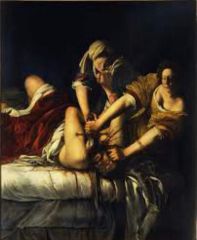
|
N-Judith and Holofernes D-1620 P/S-17th Century Boroque A-Gentilenschi OL-Italy P-The Pope M/T-Oil painting F-Propaganda DT-Tenebrism C-Political, Religious |
|

|
N- Apollo 11 Stones D-23,000 BCE P/S- Mesolithic, Neolithic A- N/A OL- Namibia P- N/A M/T- Charcoal F- Recreational DT- Silhouette C- Historical |
|
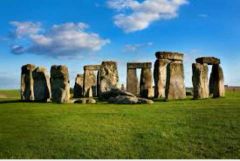
|
N- Stonehenge D- 2000 BCE P/S- Paleolithic A- N/A OL- Wiltshire, England P-N/A M/T- Stones in ground, Post and Lintel F- Ritual, Calendar DT- Trilith C- No easy way to be transported, Could be used for Rituals. |
|
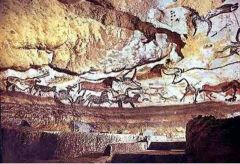
|
N- Great Hall of Bulls D- 13,000 BCE P/S- Prehistoric A- Unknown OL- Lascaux, France P- N/A M/T- Charcoal F- Recreation DT- Twisted perspective C- Ground line, could be multiple artists |
|

|
N- Running horned women D- 6000-4000 BCE P/S- Prehistoric A- Unknown OL- Algeria P- N/A M/T- Pigment on rock F- Ritual DT- Symbolic C- Running woman w/ body paint, raffia skirt, & horned headgear |
|
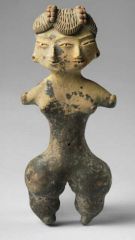
|
N- Tlatilco female figurine D- 1200-900 BCE P/S- Prehistoric A- Unknown OL- Mexico P- N/A M/T-Clay F- Afterlife purposes DT- Stylized C- Found in burial site, could be for life after death |
|
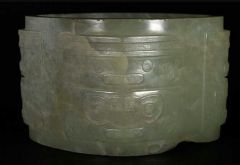
|
N- Jade Cong D- 2500 BCE P/S- Neolithic A- Unknown OL- China P- Jade, Sanding M/T- Found at burial site F- Cong D/T- Monster face C- Could symbolize life after death |
|
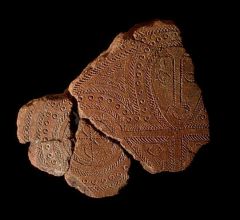
|
N- Terra Cotta Fragment D- 1000 BCE P/S-Prehistoric A- Unknown OL- Solomon Islands P- N/A M/T- Terra Cotta, Incised F- Pottery for cooking DT- Ceramic C- Geometric Patterns |
|
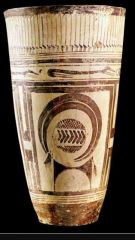
|
N- Bushel w/ ibed motifs D- 4200-3500 BCE P/S- Prehistoric A- Unknown OL- Iran P- N/A M/T- Handmade w/ clay F- Buried w/ dead DT- Geometric forms, stylized C- Found while archeologists were looking for the tomb of David |
|
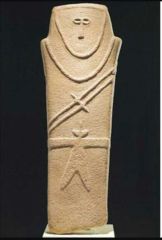
|
N- Anthropomorphic Stele D- 4000-3000 BCE P/S- A- Unknown OL- Saudi Arabia P- N/A M/T- Sandstone F- Possibly for burial practices DT- Slab carved for depicting images C- Found in 2010 by camel herder |
|
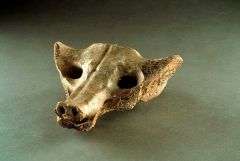
|
N- Sacrum bone in shape of canine D- 14000-7000 BCE P/S- Prehistoric A- Unknown OL- Mexico P- N/A M/T- Sacrum Bone F- Spiritual, Religious ceremony DT- Carved, shaped like canine head C- Believed to be part of the male reproductive system |
|
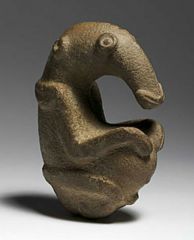
|
N- Ambum Stone D- 1500 BCE P/S- Prehistoric A- Unknown OL- New Guinea P- N/A M/T- Greywacke F- Considered savred DT- Pestles C- Discovered in a cave |
|
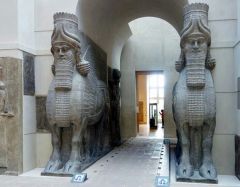
|
N- Lamassu from the Citadel of Sargon II D- 720-705 BCE P/S- Neo-Semarian A- Unknown OL- Dur Sharrukin P- N/A M/T- Alabaster F- Protect and support important doorways in Assyrian palaces DT- Lamassu, huma head with body of bull and large wings C- Used as a form of intimidation, to show power/strength, to show wealth. |
|
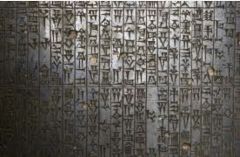
|
N- Code of Hammurabi D- 1792-1750 BCE P/S- Neo-Semarian A- Unknown OL- Babylon P- Hammurabi M/T- Code of law carved into 8ft tall black stone F- System of Babylonian laws DT- Basalt, Carved, code of laws C- 1st known set of ruler enforced laws, 300 very strict laws on 1 large stone |
|

|
N- Standard of Ur from the royal tombs D- 2600-2400 BCE P/S- Ancient Near East A- Unknown OL- Ur P- King of Ur atm M/T- Wood inlaid with shell, lapis lazuli, with red limestone F- Likely to have been a sound box for a musical instrument DT- Hollow wooden box, detailed with war and animals C- Found in one of the Royal Tombs, original function unknow |
|
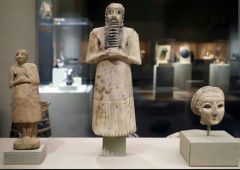
|
N- Statues of Votive Figures D- 2700 BCE P/S- Ancient Near East A- Unknown OL- Square Temple at Eshunna P- N/A M/T- Gypsum inlaid with shell and black limestone F- Surrogates for donor offering constant prayer to dirty. DT- Wide, humble eyes with arms clasped, looks as if begging C- Offerings to gods as passage to afterlife. |
|
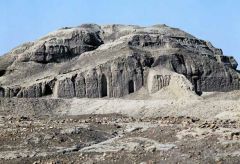
|
N- White Temple and its Ziggurat D- 3500-3000 BCE P/S- Ancient Near East A- Unknown OL- Uruk P- Unknown M/T- Mud Brick F- Temple; meeting place for gods and humans DT- Brick, Temple, Steps, Platform C- Surrogate statues of humans were placed in rooms of the temple to "beg" and "plead" to the gods for entrance to afterlife. |
|

|
N- Palette of Kimg Narmer D- 3000-2920 BCE P/S- Ancient Egypt A- N/A P-N/A OL- Egypt M/T- Greywacke, schist F- Votive or gift offering by king to his "father", god Amunra C- Believed to be found in predynastic capital of Egypt DT- Shield-Shaped, decorated on both sides |
|
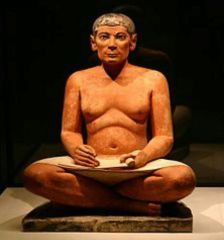
|
N- Seated Scribe D- 2620-2500 BCE P/S- Ancient Egypt A- N/A P- N/A OL- Egypt M/T- Painted limestone, rock crystals, magnesite, copper/arsenic F- Represent a scribe for the interior of the tomb C- placid inside tombs DT- Realistic, lively, representational, rigid |
|
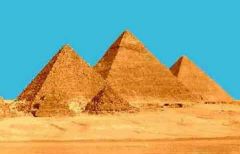
|
N- Great Pyramids and Sphinx D- 2550-2490 BCE P/S- Ancient Egypt A- N/A P- Pharaoh of the time OL- Giza, Egypt M/T- Cut Limestone F- Great tombs for the pharaoh, held all he needed for the afterlife; sphinx was a symbol of power C- Great sphinx considered the most immense sculpture made by man; pyramids were giant tombs for the pharaoh DT- Stone, tombs, statues, animal symbolism |
|
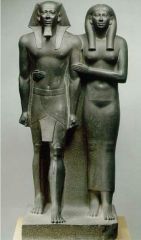
|
N- King Menkaura and Queen D- 2490-2472 P/S- Ancient Egypt A- N/A P- N/A OL- Egypt M/T- Greywacke F- sculpture of pharaoh and wife to show that the pharaoh was as close to a god as possible C- Found in a hole dug earlier by by treasure hunters below the floor of a room of one of the pyramids DT- representational, symmetrical, proportional, hierarchial structure |
|
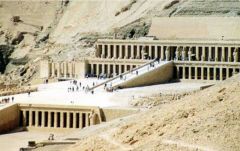
|
N- Mortuary Temple of Hatsheput D- 1473-1458 BCE P/S- Egyptian A- Senmut P- Hatsheput OL- Near Luxor M/T- Sandstone, partially carved into rock, red granite F- Funerary Temple for queen of the time C- Built for the queen to commemorate her achievements and act as a mortuary for her and the god Amun Ra DT- Granite, sand stone, cliff carving |
|
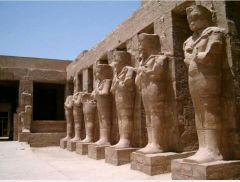
|
N- Hypostyle Hall D- 1250 BCE P/S- New Kingdom A- N/A P- N/A OL- Karnak near Luxor M/T- Cut Limestone and mud brick F- Major portion for temple for the god Amun Ra C- Represented a marsh in the beginning of time DT- Pillars, hall, sandstone, religious practices |
|
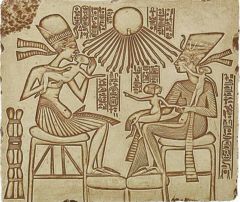
|
N- Akhenaten, Neferiti, And 3 daughters D- 1353-1335 BCE P/S- New Kingdom A- N/A P- N/A OL- Near Luxor M/T- Limestone F- To depict Akhenaten and his wife and 3 daughters and their relation the the god Aten C- A piece that would be in somebody's home, not a public place, depicting relationship between god and ruler DT- Limestone God-to-ruler relationship, Aten, religious sculpture |
|
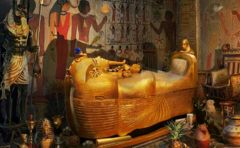
|
N- Tutankhamun's Tomb, innermost coffin D- 1323 BCE P/S- New Kingdom A- N/A P-N/A OL- Egypt M/T- Gold Interlay with enamal and semiprecious stones F- Cpffin for King C- Coffin With King's tomb, held his mummified bodyDT- Gold coffin, tomb, afterlife, Mummified King |

